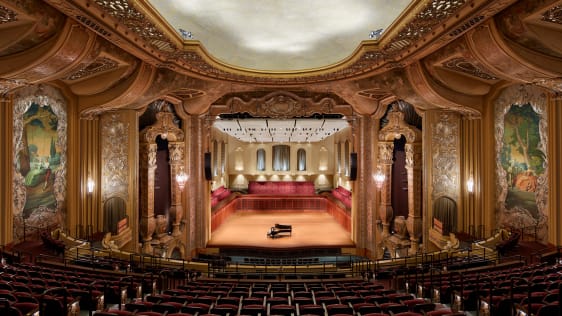Community, Leadership, Experimentation, Diversity, & Education
Pittsburgh Arts, Regional Theatre, New Work, Producing, Copyright, Labor Unions,
New Products, Coping Skills, J-O-Bs...
Theatre industry news, University & School of Drama Announcements, plus occasional course support for
Carnegie Mellon School of Drama Faculty, Staff, Students, and Alumni.
CMU School of Drama
Monday, February 28, 2022
How a lavish 1930s theater was reborn as an acoustical paradise
www.fastcompany.com: The perfect acoustics aren’t always visible to the naked eye.
Once a lavish cinema owned by Warner Brothers studio, the Warner Grand Theater in Milwaukee has been transformed into an acoustic paradise for the Milwaukee Symphony Orchestra. The four-year-long renovation involved moving a 625-ton, 85-foot-tall wall into the street to make room for a larger stage, and introducing a slew of hidden acoustical features to make the space sound as good as it looks.
Subscribe to:
Post Comments (Atom)

3 comments:
Not only is the theater absolutely stunning architecturally, it is also a hidden gem. I say hidden because to the untrained ear, the only acoustical detail someone may notice is if it is truly incomprehensible or terribly designed. Only designers, musicians, composers, or other avid sound lovers can pick up on the details of sound. On a different note (excuse the pun) I think the idea of restoring historical buildings to restore their function and purpose in society. This prevents unnecessary waste as well as some sort of physical and emotional connection to history. Also frankly, classic vintage architecture is really cool, it can be a really interesting milestone in history, and a type of physical mile marker. This theater seems to be a million different buildings from different types collaged into one. It feels visually curated in a way that is thought provoking and intellectually stimulating. Visually and auditorily, the engineering and design in this building is so intriguing.
The theater is gorgeous. I can only imagine what the sound quality is because of the acoustics too. But simply from an architectural standpoint, I would love to go inside and just wander around for a while and take a lot of photos for memory keeping. I think it’s great how there is still money to be invested in maintaining the integrity of old buildings. Back in my hometown, oftentimes historic buildings are left to decay and degrade over time. Architecture is part of history, it is after all a kind of art in itself. I of also think that their solution to keep the façade of the building while also acknowledging they needed to make the stage larger was genius. I can only imagine how difficult the details of making that acoustic effect also work in that larger venue went, but from what I can see it was all certainly worth it.
I really enjoyed reading this article because it discussed the renovation process of this historic theater, rather than talking about it's new features. The renovations actually reminded me a lot about how Carnegie Mellon likes to renovate their buildings haha. They tend to keep a lot of the older architecture, but either add an extension or make the inside modern. I have a fondness for older architecture styles, so I really appreciated how they conserved some of their building as well as the antique molding styles within the theater space, while also making it a hybrid with much modern features. I especially liked the lighting they had on the outside. What really caught my attention in the article, however, is the acoustics. I feel as though good acoustics make or break a performance space, no matter how "pretty" it may look. I also think that many theaters forget about this importance much to easily. I would really love to watch a performance here to experience the acoustic renovations they have made, especially with such newer technology.
Post a Comment